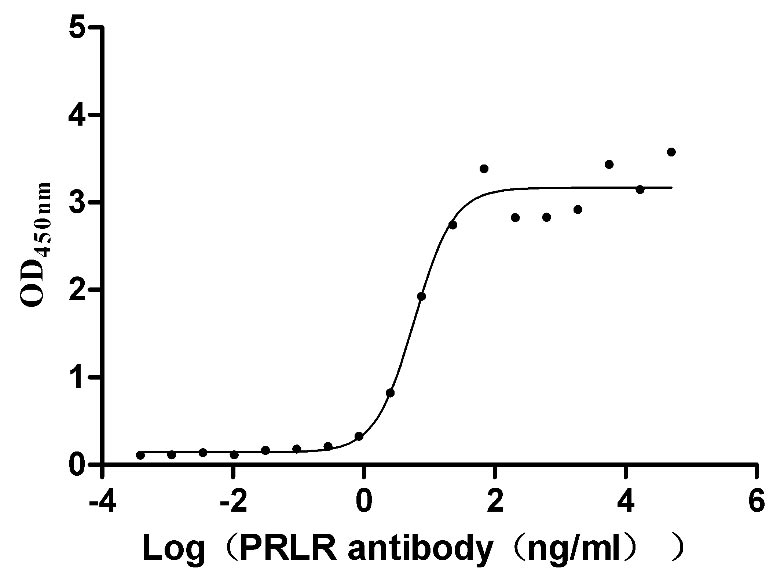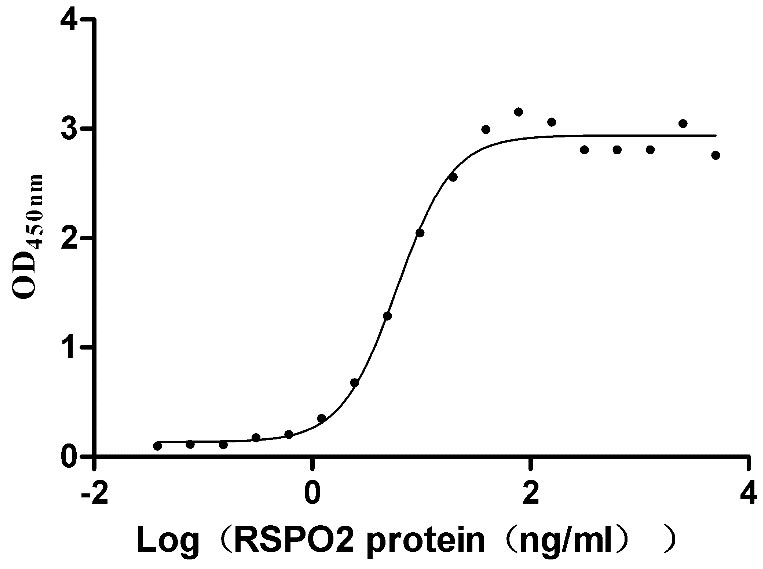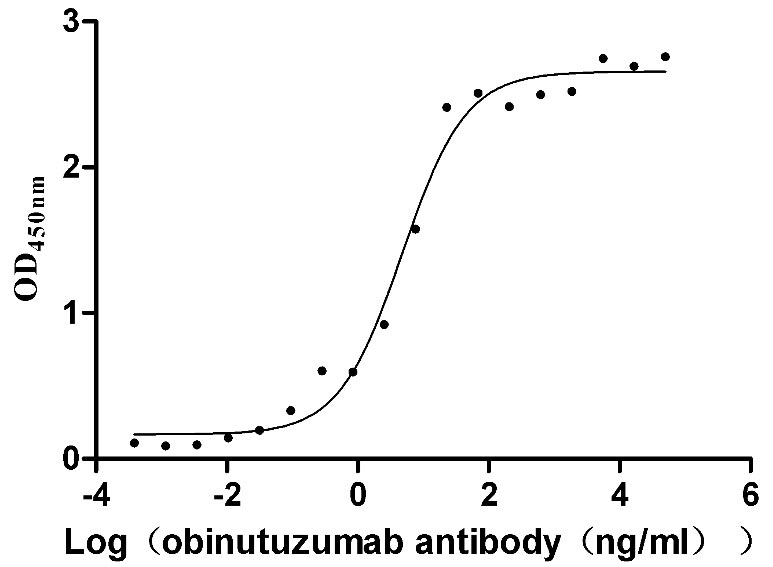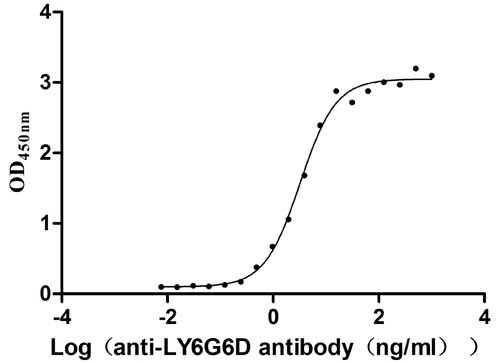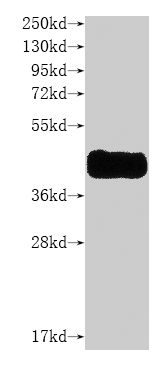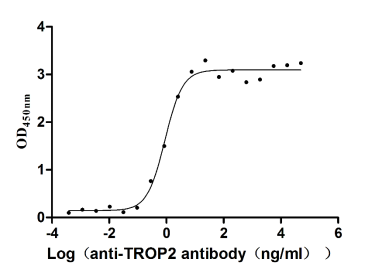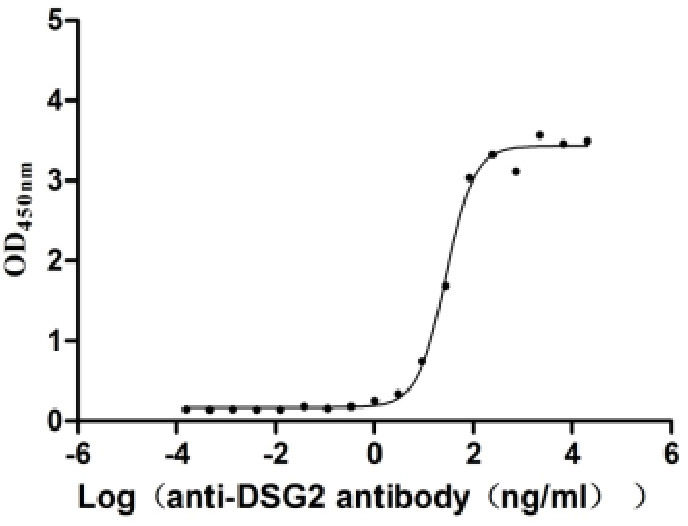Recombinant Human Minor histocompatibility antigen H13 (HM13), partial
-
中文名稱:人HM13重組蛋白
-
貨號:CSB-YP851544HU
-
規(guī)格:
-
來源:Yeast
-
其他:
-
中文名稱:人HM13重組蛋白
-
貨號:CSB-EP851544HU
-
規(guī)格:
-
來源:E.coli
-
其他:
-
中文名稱:人HM13重組蛋白
-
貨號:CSB-EP851544HU-B
-
規(guī)格:
-
來源:E.coli
-
共軛:Avi-tag Biotinylated
E. coli biotin ligase (BirA) is highly specific in covalently attaching biotin to the 15 amino acid AviTag peptide. This recombinant protein was biotinylated in vivo by AviTag-BirA technology, which method is BriA catalyzes amide linkage between the biotin and the specific lysine of the AviTag.
-
其他:
-
中文名稱:人HM13重組蛋白
-
貨號:CSB-BP851544HU
-
規(guī)格:
-
來源:Baculovirus
-
其他:
-
中文名稱:人HM13重組蛋白
-
貨號:CSB-MP851544HU
-
規(guī)格:
-
來源:Mammalian cell
-
其他:
產(chǎn)品詳情
-
純度:>85% (SDS-PAGE)
-
基因名:HM13
-
Uniprot No.:
-
別名:dJ324O17.1; H13; hIMP1; Histocompatibility (minor) 13; HM13; HM13_HUMAN; IMP-1; IMP1; IMPAS; IMPAS-1; Intramembrane protease 1; Intramembrane protease; Minor histocompatibility antigen 13; Minor histocompatibility antigen H13; MSTP086; OTTHUMP00000030527; OTTHUMP00000030528; OTTHUMP00000030530; OTTHUMP00000214528; Presenilin-like protein 3; PSENL3; PSL3; Signal peptide peptidase; Signal peptide peptidase beta; SPP
-
種屬:Homo sapiens (Human)
-
蛋白長度:Partial
-
蛋白標(biāo)簽:Tag?type?will?be?determined?during?the?manufacturing?process.
The tag type will be determined during production process. If you have specified tag type, please tell us and we will develop the specified tag preferentially. -
產(chǎn)品提供形式:Lyophilized powder
Note: We will preferentially ship the format that we have in stock, however, if you have any special requirement for the format, please remark your requirement when placing the order, we will prepare according to your demand. -
復(fù)溶:We recommend that this vial be briefly centrifuged prior to opening to bring the contents to the bottom. Please reconstitute protein in deionized sterile water to a concentration of 0.1-1.0 mg/mL.We recommend to add 5-50% of glycerol (final concentration) and aliquot for long-term storage at -20℃/-80℃. Our default final concentration of glycerol is 50%. Customers could use it as reference.
-
儲存條件:Store at -20°C/-80°C upon receipt, aliquoting is necessary for mutiple use. Avoid repeated freeze-thaw cycles.
-
保質(zhì)期:The shelf life is related to many factors, storage state, buffer ingredients, storage temperature and the stability of the protein itself.
Generally, the shelf life of liquid form is 6 months at -20°C/-80°C. The shelf life of lyophilized form is 12 months at -20°C/-80°C. -
貨期:Delivery time may differ from different purchasing way or location, please kindly consult your local distributors for specific delivery time.Note: All of our proteins are default shipped with normal blue ice packs, if you request to ship with dry ice, please communicate with us in advance and extra fees will be charged.
-
注意事項:Repeated freezing and thawing is not recommended. Store working aliquots at 4°C for up to one week.
-
Datasheet :Please contact us to get it.
相關(guān)產(chǎn)品
靶點詳情
-
功能:Catalyzes intramembrane proteolysis of some signal peptides after they have been cleaved from a preprotein, resulting in the release of the fragment from the ER membrane into the cytoplasm. Required to generate lymphocyte cell surface (HLA-E) epitopes derived from MHC class I signal peptides. May be necessary for the removal of the signal peptide that remains attached to the hepatitis C virus core protein after the initial proteolytic processing of the polyprotein. Involved in the intramembrane cleavage of the integral membrane protein PSEN1. Cleaves the integral membrane protein XBP1 isoform 1 in a DERL1/RNF139-dependent manner. May play a role in graft rejection.
-
基因功能參考文獻(xiàn):
- Preproinsulin signal peptide epitopes are processed by SPP and loaded for HLA-guided immune recognition via pathways that are enhanced during type 1 diabetes pathogenesis. PMID: 29343547
- Though far from complete, our knowledge on pathophysiological functions of SPP/SPPL proteases, in particular based on studies in mice, has been significantly increased over the last years. Based on this, inhibition of distinct SPP/SPPL proteases has been proposed as a novel therapeutic concept e.g. for the treatment of autoimmunity and viral or protozoal infections, as we will discuss in this review. PMID: 28624439
- The domains involved in HO-1 translocation have been identified, and it was shown that SPP-mediated HO-1 cleavage is isoform-specific (HO-1 vs HO-2) and independent of heme oxygenase activity. PMID: 29155886
- This study identifies that SPP affects EGFRvIII secretion profiles and thus promotes tumor progression, providing further understanding of the formation of secreted vesicles and driving role of EGFRvIII in Glioblastoma. PMID: 28198167
- structure of human SPP [SPP] PMID: 21636854
- identified human signal peptide peptidase as a polytopic membrane protein with sequence motifs characteristic of the presenilin-type aspartic proteases [SPP] PMID: 12077416
- identification and molecular cloning; expression analysis of the hIMP1 gene (located on chromosome 20) was performed in human cell tissues and transfected cell cultures [IMP1] PMID: 12139484
- widespread expression of SPP in many tissues PMID: 12972007
- signal peptide peptidase forms a homodimer that is labeled by an active site-directed gamma-secretase inhibitor PMID: 14704149
- IMP1 is a bi-aspartic polytopic protease capable of cleaving transmembrane proteins such as presenilin 2. PMID: 14741365
- The peptide structure corresponding to the C-terminal residues from H13 ribosomal protein was determined using magnetic resonance spectroscopy. PMID: 14988012
- data implicate SPP in the US2 pathway and indicate the possibility of a previously unknown function for this intramembrane-cleaving aspartic protease in dislocation from the endoplasmic reticulum PMID: 16738546
- Upon isolation of membranes and solubilization with detergent, the biochemical characteristics of SPP are remarkably similar to gamma-secretase. PMID: 16834339
- Compares a variant from the mouse ortholog to the human gene. PMID: 16730383
顯示更多
收起更多
-
亞細(xì)胞定位:Endoplasmic reticulum membrane; Multi-pass membrane protein. Membrane; Multi-pass membrane protein; Lumenal side.; [Isoform 4]: Cell membrane; Multi-pass membrane protein.
-
蛋白家族:Peptidase A22B family
-
組織特異性:Widely expressed with highest levels in kidney, liver, placenta, lung, leukocytes and small intestine and reduced expression in heart and skeletal muscle. Expressed abundantly in the CNS with highest levels in thalamus and medulla.
-
數(shù)據(jù)庫鏈接:
Most popular with customers
-
Recombinant Mouse Prolactin receptor (Prlr), partial (Active)
Express system: Mammalian cell
Species: Mus musculus (Mouse)
-
Recombinant Human E3 ubiquitin-protein ligase ZNRF3 (ZNRF3), partial (Active)
Express system: Mammalian cell
Species: Homo sapiens (Human)
-
Recombinant Human B-lymphocyte antigen CD20 (MS4A1)-VLPs (Active)
Express system: Mammalian cell
Species: Homo sapiens (Human)
-
Recombinant Mouse Retinol-binding protein 4 (Rbp4) (Active)
Express system: Mammalian cell
Species: Mus musculus (Mouse)
-
Recombinant Human Lymphocyte antigen 6 complex locus protein G6d (LY6G6D) (Active)
Express system: Yeast
Species: Homo sapiens (Human)
-
Recombinant Human C-C chemokine receptor type 8 (CCR8)-VLPs (Active)
Express system: Mammalian cell
Species: Homo sapiens (Human)
-
Recombinant Human Tumor-associated calcium signal transducer 2 (TACSTD2), partial (Active)
Express system: Mammalian cell
Species: Homo sapiens (Human)
-
Recombinant Human Desmoglein-2 (DSG2), partial (Active)
Express system: Mammalian cell
Species: Homo sapiens (Human)


